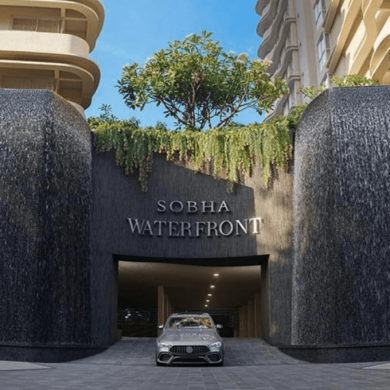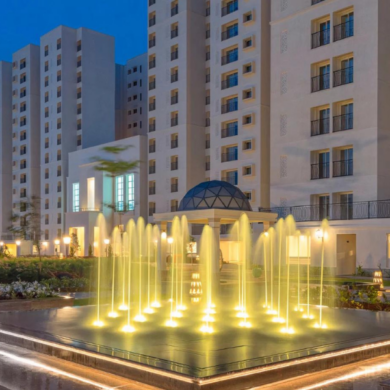
Low-rise apartments emerge as a unique & enticing choice, offering a harmonious blend of architectural charm and vibrant outdoor spaces. These abodes provide an inviting haven for those seeking a balance between modern comforts and a sense of community.
Among the various options available, low-rise apartments stand out as a compelling choice with multiple advantages. These building complexes, characterised by their modest height and intimate scale, offer a range of benefits that cater to different aspects of modern living.
From architectural charm and outdoor spaces to security, energy efficiency, and cost considerations, low-rise apartments provide a harmonious blend of aesthetics, functionality, and community, making them an appealing option for those seeking a balanced & fulfilling lifestyle.
Table of Contents
10 Advantages of Living in Low-rise Apartments
-
Peaceful and Quiet Environment in Low-Rise Apartments
Choosing a low-rise flat offers a range of advantages, and one prominent benefit is the serene atmosphere. Unlike their bustling high-rise counterparts, low-rise apartments foster a peaceful environment that significantly enhances the living experience.
Low Noise Levels: These abodes are inherently characterised by fewer residents and lesser vertical congestion. This reduces noise levels, as buyers are spared from the constant commotion and sound disturbances that often plague high-rise living. This quieter ambience creates an ideal setting for relaxation, work, and restful sleep.
Privacy and Personal Space: With fewer units per floor, low-rise apartments offer enhanced privacy. Residents are less likely to encounter neighbours’ hustle & bustle, enabling them to enjoy a more secluded & comfortable living space.
Connection to Nature and Surroundings: Many low-rise apartments are thoughtfully designed to provide seamless connect with the natural world. Ground-level access often means one can step out into green spaces, gardens, or courtyards with ease. This proximity to nature enhances the buyer’s visual surroundings and promotes a healthier & more calming living experience.
-
Enhanced Community Feel in Low-Rise Apartments
Unlike sprawling high-rise complexes, low-rise apartments often cultivate a tighter-knit and more connected social environment, bringing residents together in a way that can significantly enrich their living experience.
Smaller, Close-Knit Communities: Low-rise apartments typically house fewer residents than their towering counterparts. This creates an environment where neighbours become familiar faces, paving the way for genuine relationships. The smaller size of these communities makes it easier to remember names, share experiences, and create lasting bonds.
More accessible Social Interactions: Shared common spaces, such as courtyards, gardens, or lounges, become natural meeting points for residents to engage in casual conversations, nurturing a friendly & welcoming atmosphere. These spaces often become hubs for impromptu gatherings & events.
Sense of Belonging and Shared Spaces: Residents of low-rise apartments often share similar living experiences, interests, and challenges, leading to better camaraderie. The presence of areas like barbecue pits, fitness centres, and playgrounds provides opportunities for residents to come together.
-
Accessibility and Convenience in Low-Rise Apartments
Living in low-rise apartments offers a host of accessibility and convenience benefits that cater to today’s fast-paced lifestyle. With minimal or no elevator dependency, residents enjoy the freedom of swift mobility around their homes. The advantage of quick access to both their flats and essential amenities contributes to a convenient living experience.
Furthermore, the ease of moving in and out is unparalleled. Say goodbye to the logistical challenges often associated with higher floors – low-rise apartments simplify the process, making transitions hassle-free. Whether it is moving furniture, welcoming guests, or even bringing in the groceries, the ground-level advantage of low-rise living ensures convenience at every step.
-
Natural Light and Ventilation
With ample sunlight streaming in throughout the day, these abodes create an ambiance that enhances aesthetics and promotes well-being. The presence of daylight doesn’t just illuminate rooms; it positively impacts residents’ moods & productivity. In addition to the vibrant illumination, low-rise buildings have better indoor air quality. Proper ventilation is often easier in these structures, as openings can be strategically positioned for cross-ventilation.
Many lower-floor buildings have direct access to gardens, patios, or terraces, offering a seamless blend of indoor & outdoor living. This connection to nature encourages residents to embrace outdoor lifestyles, fostering well-rounded living.
-
Architectural Charm and Aesthetics
Unique designs and individuality: Unlike towering high-rises, each low-rise apartment building tends to have its own distinct architectural identity, showcasing diverse styles that cater to different tastes. This uniqueness adds character to the living space and promotes a sense of individuality among residents.
Cosy Atmosphere: The modest height of these buildings fosters a more intimate living environment, making residents feel connected to their surroundings. The smaller scale of these flats encourages a close-knit community feel, where neighbours interact more frequently and develop a sense of belonging.
Integration with Surrounding Landscape: These buildings harmoniously blend into their natural surroundings, often incorporating green spaces, courtyards, and gardens. This integration
-
Outdoor Spaces and Amenities in Low-Rise Apartments
Low-rise apartments offer residents a closer connection to nature and a range of facilities that promote a healthy & active lifestyle.
Gardens, Patios, and Balconies: These apartments often have the luxury of private outdoor spaces. Residents can enjoy coffee on a cosy balcony, nurture plants in personal gardens, or unwind on charming patios.
Recreational Areas and Playgrounds: These spaces are hubs for social interactions, picnics, and outdoor play. They foster a sense of community, where neighbours can come together for shared experiences.
Fitness Facilities and Pools: Many low-rise apartments incorporate these within their premises. Residents have the convenience of staying active without leaving the complex. Fitness centres equipped with modern equipment and well-maintained pools offer opportunities for exercise & relaxation, promoting a balanced lifestyle.
From intimate balconies to vibrant gardens, from lively playgrounds to invigorating fitness facilities, these features cater to diverse preferences and enhance the overall quality of life. They encourage residents to embrace an outdoor-oriented lifestyle while fostering the spirit of community living.
-
Security and Safety in Low-Rise Apartments
Low-rise apartments offer a range of advantages that provide peace of mind to residents.
Limited Access Points: Controlled entry helps regulate the entry & exit of visitors in the premises. Security personnel & technology can focus better on fewer entryways, making it easier to track visitor records and ensure only authorised persons gain access.
Better Supervision and Surveillance: Security personnel, as well as residents themselves, can easily monitor communal areas, corridors, and entrances. This increased visibility is a deterrent to potential security breaches, and provides quick response in case of any unusual activities.
Enhanced Sense of Security: The compact nature of low-rise apartments fosters a stronger sense of community. Neighbours know each other better, creating a network of mutual trust & vigilance. This heightened community awareness contributes to an enhanced sense of security, as residents look out for each other and report any unusual occurrences promptly.
-
Energy Efficiency and Sustainability in Low-Rise Apartments
Low-rise apartments offer energy efficiency and sustainability advantages through reduced consumption, lower maintenance costs, and eco-friendly practices.
Reduced Energy Consumption: Low-rise apartments generally have fewer units and lower floor-to-ceiling heights compared to high-rises. This translates to reduced energy consumption for heating, cooling, and lighting.
Lower Maintenance Costs: The modest scale of low-rise apartments often leads to lower maintenance costs. The overall maintenance and repair expenses are more manageable with fewer shared facilities & systems, such as elevators.
Potential for Eco-friendly Practices: Residents can explore renewable energy options like solar panels, implement water-saving technologies, and cultivate community gardens. The manageable sizes of these buildings facilitate the implementation of sustainable practices on a smaller scale, making it easier to create a greener living environment.
-
Cost Consideration in Low-Rise Apartments
Low-rise apartments offer distinct cost considerations, including potentially lower purchase / rental costs, maintenance savings, and the potential for better resale value:
Lower Purchase / Rental Costs: Higher prices often reflect the construction & maintenance expenses associated with towering structures. With their more modest scale, low-rise apartments can provide a more affordable entry point into homeownership or renting in desirable locations.
Maintenance Savings: The simplicity of their design and the reduced number of shared amenities lead to decreased maintenance expenses. This can translate to significant savings for residents, allowing them to allocate their resources elsewhere.
Potential for Better Resale Value: Over time, low-rise apartments may hold the advantage of better resale value. The initial affordability, combined with the enduring appeal of a more intimate living environment, can contribute to sustained demand in the real estate market.
-
Lifestyle Alignment and Personal Choice
Diverse layouts and designs of low-rise apartments allow residents to choose a living space that resonates with their tastes. Whether it’s a cosy studio or a spacious duplex, these apartments cater to a variety of preferences, ensuring that residents find homes that align with their unique lifestyle needs.
With fewer floors to navigate and a more intimate community, residents often experience a streamlined & efficient daily life. The convenience of access and the warmth of a close-knit community enhance the quality of life and contribute to a more fulfilling lifestyle.
Also Read More:
1. 8 Benefits of Living in An Apartment Complex
2. Benefits of First-Time Home Buyer
3. 10 Things to Check to Ensure You Select the Right Real Estate Builder
Final Thoughts
The advantages of living in low-rise apartments are diverse and appealing. From their unique architectural charm and integration with nature to the emphasis on outdoor spaces, security, energy efficiency, and cost considerations, these flats offer a well-rounded living experience.
The ability to cater to individual preferences and align with various lifestyles adds to their allure. These low-rise flats stand testament to the idea that a home is not just a physical space but a reflection of personal choices and a foundation for a fulfilling life.
FAQs –
1. Why are low-rise buildings better?
Low-rise buildings are better as they have unique designs and they foster individuality. Cosy atmospheres and integration with nature provide a sense of belonging. Limited access points enhance security while reduced energy consumption & maintenance costs make them efficient. Low-rises cater to personal choices and often have better resale value.
2. Which is better, high-rise or low-rise?
Low-rise flats are better than high-rise ones, in terms of architectural charm, customisation, privacy, and community. Low rises have potentially lower costs, enhanced security, and manageable maintenance, while high-rises offer city views & amenities. Take a balanced decision, considering your lifestyle priorities, location preferences, and budget.
3. What are the disadvantages of living in high-rise buildings?
Disadvantages of living in high-rise buildings are dependency on elevators leading to high wait times, limited outdoor spaces, privacy concerns, high maintenance costs, increased noise levels, and higher energy consumption.
4. What is the difference between low-rise and high-rise buildings?
The key difference between low-rise and high-rise buildings is that low-rise apartments are shorter, often built with unique designs, and offer a cosy atmosphere. They integrate well with nature and have limited access points for better security. High-rise homes are taller, offer city views, and have shared amenities. They might have longer elevator wait times and higher maintenance costs.










